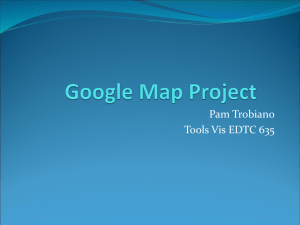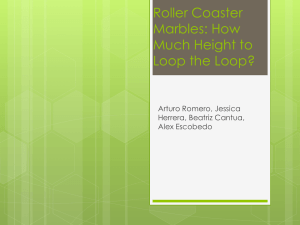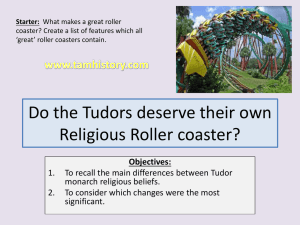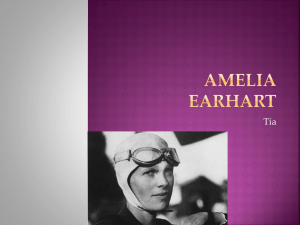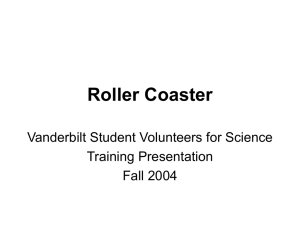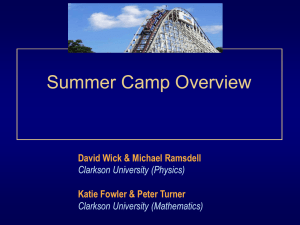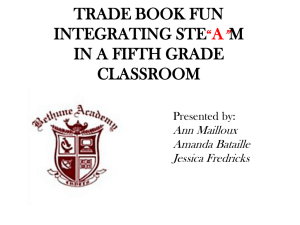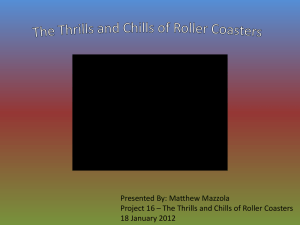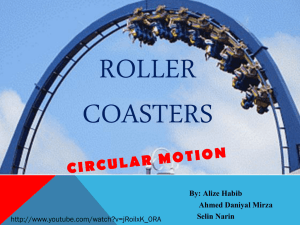What Goes Up Must Come Down Roller Coaster Physics
advertisement
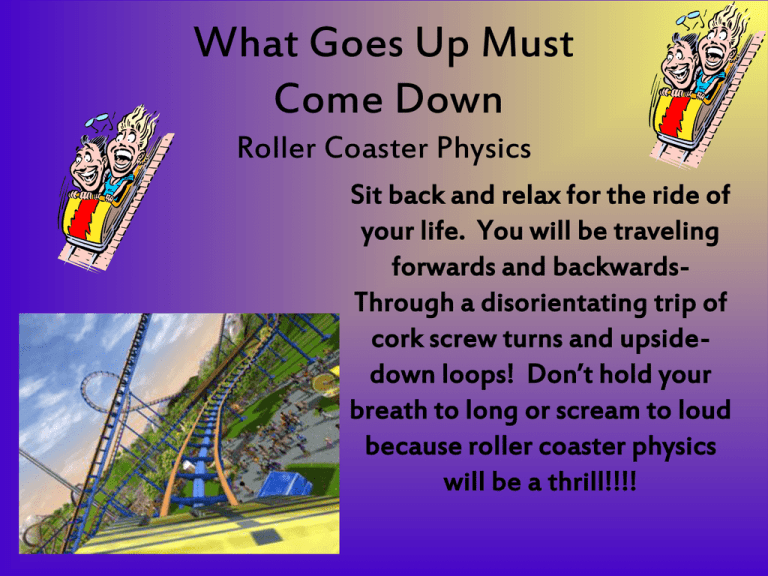
What Goes Up Must Come Down Roller Coaster Physics Sit back and relax for the ride of your life. You will be traveling forwards and backwardsThrough a disorientating trip of cork screw turns and upsidedown loops! Don’t hold your breath to long or scream to loud because roller coaster physics will be a thrill!!!! Task Your task is to research the history and design of roller coasters with the use of terms relating to Newton’s Laws of motion and force. Once you feel confident in your research your team is responsible for naming and designing the world’s fastest and most exciting roller coaster. Process This web-quest should be completed in groups of 3-5 people and will be completed in 8 days. The first 3 days of class will be spent in the computer lab finding your research. This research will be compiled into a group PowerPoint presentation. Day 4 will be used completing an interactive roller coaster lab. The next 3 days you will be building your roller coaster either on the computer or a scale model with your own materials. On the final day, your group will be presenting your PowerPoint presentation and roller coaster to class. Each person in your group will be given a task to choose from: 1) Newtonian Physicist 2) Roller Coaster Enthusiast/Historian 3) Roller Coaster Designer/Architect 4) Engineer/Safety Coordinator Newtonian Physicist o This person will be researching Sir Issac Newton, Newton’s Three Laws of Motion, and vocabulary that relates to the three laws. o Some key terms are listed below: *Newton’s 1st Law of Motion *Newton’s 2nd Law of Motion *Newton’s 3rd Law of Motion *centrifugal force *Biography of Sir Issac Newton *Acceleration *Inertia *Force *Friction *Centripetal Force *Velocity *Kinetic Energy *Gravity *Potential Energy *centripetal force *Speed *G Force Roller Coaster Enthusiast/Historian This person will research the history of roller coasters. When and where were the first roller coasters first created? When and where was the first roller coaster in the US? How they have changed over the years? Why the best roller coasters are the best and the worst roller coasters are the worst? You will also compile pictures and information describing some of the most popular roller coasters ever built. (Statistics of some of the most popular roller coasters must also be included in your information) You may add any information about roller coasters that you have been on. Roller Coaster Designer/Architect This person will investigate the components and styles of roller coasters. Questions to be answered could include (but are not limited to): Roller Coasters are made of what materials? The process individuals must take to design roller coaster. What styles are the most popular and the least popular? You must include pictures and diagrams of various roller coasters you felt were the most exciting to research. Engineer/Safety Coordinator This person will compile mathematical formulas and terminology to be used in the designing of the roller coaster.(hint: find Emotion, E position, Etotalmotion) They will also research safety, insurance, and liability issues involved in the building of roller coasters. Virtual Roller Coaster Once you have finished your research and PowerPoint, go to the link below which will take you to a virtual roller coaster. You need to make the roller coaster loop the loop. You should complete 10 attempts on the virtual roller coaster. Change the physics variables each trial and create a log of the settings you used on your own paper. Click the trial log below to see an example. Discuss how each setting affected the results positively or negatively and why? You will turn in your trials on the day you present. Funderstanding Trial Log Trial Log 1)Explain your settings (or change from last trial) 2)Did the roller coaster complete its run Circle yes or no 3)Was the result better than the last trial? Circle yes or no 4) Why or why not? Designing Your Roller Coaster Once the trials are completed, your group has enough information to design and build your own roller coaster. Your group needs to decide if you would like to build a roller coaster on the computer or a model of a roller coaster with your own material. Be sure to determine the heights of the hill, how many hills, number of loops, turns, and etc. Once the roller coaster is designed, the group needs to get all of their information, trials, powerpoint, sketches, and questions together and be ready to present to the class. Make sure you NAME your roller coaster before the presentation. If time allows make a sign. Group Questions Answer these questions when your project is completely finished. 1)Describe when and how each of Newton’s Laws of Motion are acting on a person riding a roller coaster. 2) Can the coaster have too much speed at the beginning of the trial? Explain. 3) Why do roller coasters always start out by pulling you up a big hill? 4) When does a coaster have a large amount of Kinetic Energy and when does it have a large amount of Potential Energy? 5) What would happen if there was something on the track, which caused a lot of friction between the car, and the track? 6) When are riders most affected by centripetal force? 7) What would happen to a roller coaster if gravity was suddenly increased or decreased? 8) What does it mean if you “pull 3 g’s” in a loop? Resources Worlds of Fun Inventing the Scream Machine How Stuff Works Funderstanding Discovery Amusement Park Physics History of Roller Coasters Discovery: Build a Roller Coaster History Roller Coaster Database Evaluation Rubric Conclusion CONGRATULATIONS! You have researched and designed an extreme roller coaster. Hopefully, this activity has given some insight why roller coasters are thrilling examples of the Laws of Motion. Don’t be scared because now you understand why your body reacts the way it does to gravity, acceleration, and fast changes in direction. Now, go ride the biggest and the baddest roller coasters, if you dare!
